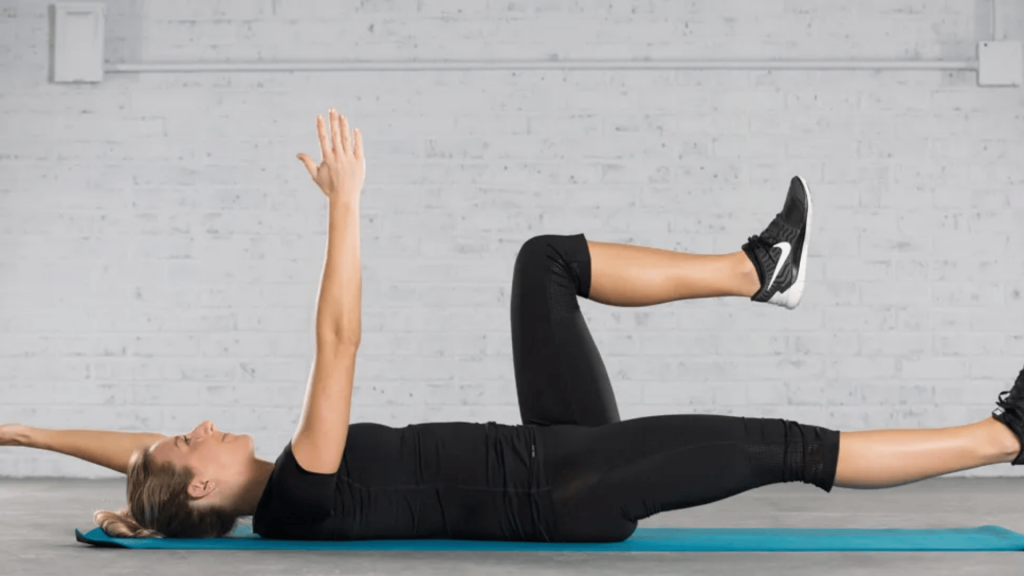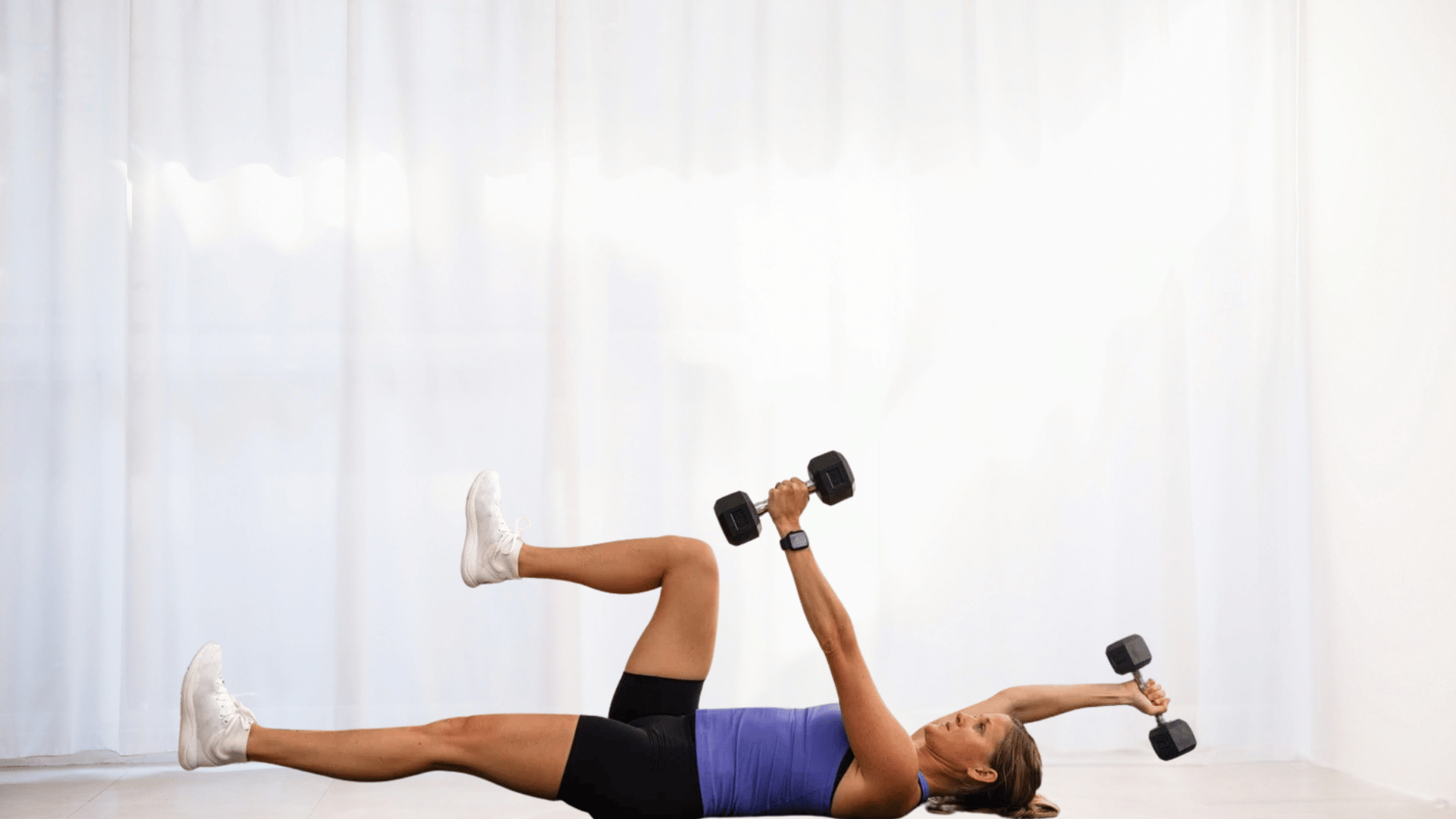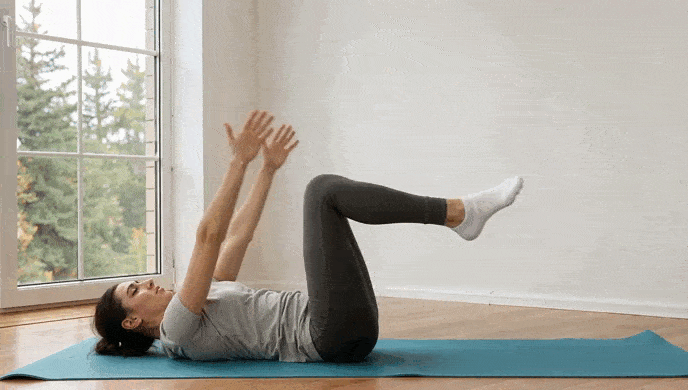Most fitness enthusiasts agree that finding an exercise that strengthens the core while being gentle on the back can be challenging.
Many people struggle with traditional ab workouts that fail to effectively engage the deep stabilizing muscles.
The dead bug exercise offers a solution that’s both accessible and highly effective, as it targets the deep abdominal muscles and improves overall stability, making it suitable for all fitness levels.
This blog will explain the key dead bug exercise benefits and provide easy-to-follow steps that anyone can master.
What is a Dead Bug Workout?
The dead bug exercise gets its quirky name from the position it mimics.
Picture a bug lying on its back with legs in the air, which is the starting pose. This core exercise involves lying flat on the ground.
The person keeps their back pressed against the floor while moving opposite arms and legs in a controlled pattern.
It’s a fundamental movement that targets deep abdominal muscles. But it’s not just about the abs, as this exercise engages the entire core system.
The charm lies in its simplicity. No equipment is needed, and it can be done anywhere with sufficient floor space. Many physical therapists recommend dead bugs as a rehabilitation tool.
Core Dead Bug Exercise Benefits

Dead bug exercises pack a serious punch when it comes to core training, and understanding the dead bug exercise benefits can completely change your workout routine.
They might look simple, but the benefits run deep from strengthening your abs to protecting your lower back and improving your overall stability.
1. Strengthens Deep Core Muscles
Dead bugs activate the transverse abdominis, which is the body’s natural weight belt. This deep muscle wraps around the torso like a corset.
Most traditional ab exercises miss this important layer. But dead bugs specifically target these stabilizing muscles that support proper posture and movement.
2. Improves Spinal Stability
The exercise teaches the spine to stay neutral under stress. This translates to better posture throughout daily activities.
Many back problems stem from poor spinal control. Dead bugs help train the muscles that maintain proper spinal alignment during movement.
3. Improves Mind-Muscle Connection
Performing dead bugs requires serious concentration. The person must coordinate opposite limbs while maintaining core engagement.
This mental focus strengthens the connection between the brain and muscles. Over time, this improved awareness carries over into other exercises and daily movements.
4. Reduces Lower Back Pain
Physical therapists often prescribe dead bugs for back pain relief. The exercise strengthens supporting muscles without stressing the spine.
Unlike crunches or sit-ups, dead bugs don’t compress the spine. Instead, they teach proper core activation that protects the lower back.
5. Builds Functional Strength
Dead bugs mimic real-world movement patterns. Walking, running, and climbing all require opposite arm-leg coordination. This exercise trains the body for everyday activities.
The strength gained translates directly to better performance in sports and daily tasks.
6. Suitable for All Fitness Levels
Beginners can start with simple arm or leg movements. Advanced exercisers can add resistance bands or weights for extra challenge.
The exercise adapts easily to different abilities. This makes it perfect for rehabilitation, fitness maintenance, or athletic performance training.
The dead bug workout proves that effective workouts don’t need to be complicated. This simple movement delivers impressive results for core strength and spinal health.
How to do the Dead Bug Exercise in Correct Manner?
Getting the dead bug right is all about nailing the setup first. Then it’s just a matter of moving slowly and staying in control.
Step 1: Get Into the Starting Position
Lie flat on the back with the knees bent at 90 degrees. The feet should be off the ground, creating that “dead bug” position. Arms reach straight up toward the ceiling.
Keep the lower back pressed firmly against the floor. Take a few deep breaths in this position to ensure comfort and proper alignment before moving.
Step 2: Engage Your Core
Take a moment to engage the core muscles. Think about pulling the belly button toward the spine without holding the breath. Feel the lower back pressing into the floor.
This connection must remain throughout the entire movement.
Step 3: Move Opposite Limbs
Slowly lower the right arm overhead while extending the left leg straight out. Keep both limbs hovering just above the ground. The key is moving opposite limbs together. This challenges coordination while building functional strength.
Step 4: Return to Start
Bring the arm and leg back to the starting position with control. Don’t just drop them back up. Maintain that core engagement throughout the return movement.
The muscles should stay active the entire time. The return phase is just as important as the lowering phase for building strength.
Step 5: Switch Sides
Repeat on the other side – left arm down, right leg out. This completes one full repetition of the exercise. Keep alternating sides for the desired number of reps.
Most beginners start with 5-8 per side. Rest briefly between sides if needed to maintain perfect form throughout the set.
Step 6: Focus on Breathing
Exhale during the lowering phase when muscles work hardest. Inhale as limbs return to the starting position.
Proper breathing keeps the core engaged throughout the exercise. It also prevents holding breath, which can spike blood pressure.
The dead bug workout might seem simple, but it’s one of the smartest moves anyone can add to their routine. Perfect form beats speed every single time. Start with just a few reps on each side.
Progressive Variations and Modifications to Try
Dead bugs grow with you as your strength improves. The charm lies in how easily this exercise adapts to different fitness levels. Also, there’s always a way to make it harder or easier.
- Beginner Modifications: Start by moving just one arm or one leg at a time to reduce coordination demands. Keep legs bent at 90 degrees and use a wall for foot support when learning proper form. Focus on maintaining that lower back connection to the floor before adding any complex movements
- Intermediate Progressions: Add resistance bands around your feet or hands for an extra challenge, and slow the tempo to 3-5 seconds per direction. Hold the extended position for 2-3 seconds to test core endurance and build strength.
- Advanced Variations: Hold light dumbbells or place a stability ball under the lower back for increased difficulty. Try alternating foot taps to the floor while keeping the other leg elevated to challenge active coordination. These variations should only be attempted after mastering the basic movement pattern.
The best part about these progressions is that there’s no rush to advance. Listen to the body and progress at a comfortable pace that maintains perfect form.
Adopting Dead Bug Into Routine According to Different Goals
Dead bugs fit into almost any workout plan and adapt to different goals easily. The key is matching intensity and volume to what someone wants to achieve.
| Goal | Frequency | Sets x Reps | Rest Between Sets | When to Use |
|---|---|---|---|---|
| Beginner | 3x per week | 2 sets x 5-8 per side | 45-60 seconds | Start of workout for activation or end of workout for practice |
| Core Strength | 4-5x per week | 3 sets x 8-12 per side | 30-45 seconds | Main core training block or between strength exercises |
| Endurance | 5-6x per week | 2 sets x 15-20 per side | 30 seconds | Circuit training or active recovery days |
| Warm-up | Daily | 1 set x 5-8 per side | None needed | Before squats, deadlifts, or pre-workout activation |
| Recovery | Daily | 1 set x 8-10 per side | As needed | Cool-down routine or movement breaks at work |
Start with lower rep ranges and build up gradually, as form is more important than hitting specific numbers. Consistency trumps perfection, so even 5 minutes of dead bugs on busy days beats skipping core work entirely.
Common Mistakes and How to Avoid Them
Even simple exercises can go wrong fast. These mistakes rob the dead bug of its effectiveness and might even cause problems.
Most errors happen because people try to move too quickly. Slowing down fixes about 80% of dead bug issues.
- Lower Back Arching: The lower back lifts off the floor during movement, putting stress on the spine. Start with smaller ranges of motion and focus on the lower limbs, keeping the back flat.
- Moving Too Fast: Racing through repetitions turns this into a sloppy coordination drill that misses the point. Count slowly with “one-thousand-one” for lowering, pause, then “one-thousand-one” for returning.
- Holding the Breath: Holding your breath creates unnecessary tension and can spike blood pressure dangerously. Practice the breathing pattern without moving first, and exhale during the lowering phase.
- Neck Tension: Straining the neck to look at moving limbs creates unnecessary discomfort. Keep the head relaxed against the floor with eyes looking up or closed. Place a small towel under the head for extra comfort.
- Limbs Touching the Ground: Letting arms or legs actually touch the floor reduces muscle tension. Stop the limbs just before touching the ground to maintain constant core engagement.
- Losing Hip Position: Allowing the stationary leg to drift or change angle breaks the 90-degree position. Keep the non-moving leg locked in place with the thigh perpendicular to the floor and shin parallel to the ceiling.
Catching these mistakes early prevents bad habits from forming. Most people make at least one error when starting out, and that’s normal.
Conclusion
The dead bug exercise proves that effective core training doesn’t require fancy equipment or complicated movements, and the dead bug exercise benefits extend far beyond just building abs.
From beginners learning basic core control to athletes preventing injuries, dead bugs offer something valuable for every fitness level.
Remember, most people notice an improvement in posture and reduced back discomfort within just a few weeks of regular practice.
Once you experience these benefits firsthand, you’ll understand why this simple movement has become a staple in fitness programs worldwide.








